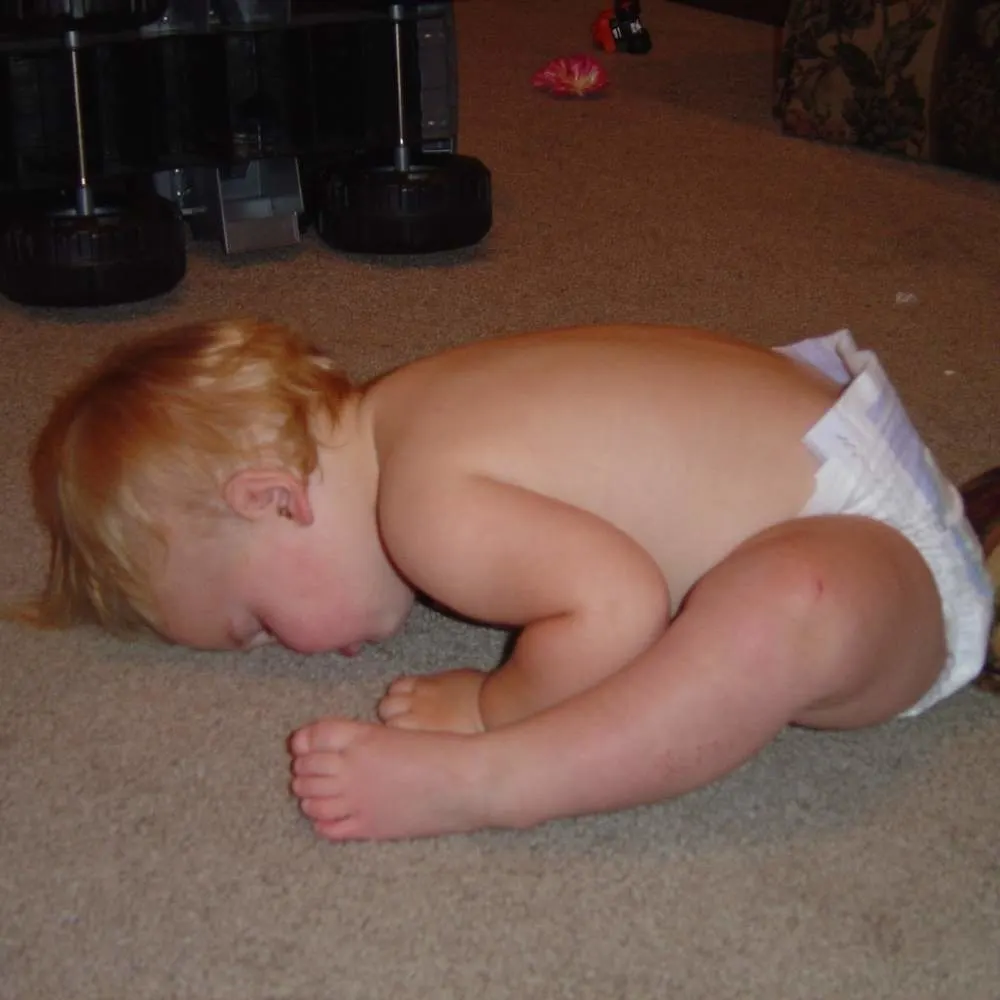- Clay Moon Phase Wall Hanging - July 4, 2023
- What To Do When a Toddler Won’t Keep Their Blanket On - June 10, 2023
- How Do Child Locks Work in Cars? (And When To Use Them!) - June 10, 2023
When my son was a toddler, he would go non-stop until he completely ran out of energy. Then, that little man would lie down wherever he was and just collapse into a deep sleep!
It’s natural to worry when you find your little one regularly falling asleep on the floor. Fortunately, most of the reasons toddlers fall asleep on the floor are harmless, and there are things you can do to encourage better sleeping habits.
Your toddler may fall asleep on the floor just because they have played so long and so hard that they literally cannot last any longer without a nap!
In this article, I’ll explore four reasons why your little one may be falling asleep on the floor, as well as several ways to encourage your toddler to sleep in their own bed.

Moved Out of the Crib Too Soon
If you notice your toddler sleeping on the floor after switching from a crib to a toddler bed, it could be that the child is protesting the change.
When transitioning to a toddler bed, young children may become overwhelmed. Since toddlers aren’t sure how to adequately communicate their feelings, they may act out with unwanted behaviors, such as bedtime resistance by crawling out of bed (source).
You may notice your toddler sleeping on the floor as a way to regain a sense of control in their life.
Before switching from crib to toddler bed, determine whether your child is truly ready. Some children may be prepared for a “big kid bed” as young as 18 months old, whereas some may not want to make the change until they’re as old as three.
Knowing when to transition your little one to a toddler bed depends on their maturity and whether they’re showing signs of readiness. Those signs include:
- Regularly climbing out of their crib at night or during naps
- Being almost three feet tall or taller
- Aged between 18 months and 3 years old
- Expressing an interest in toddler beds
Although most pediatricians recommend making the transition once the child is ready, it may be best to wait if the toddler is currently experiencing many life changes (i.e., the birth of a new sibling, moving, etc.). Adding another change on top of everything else could be too much for your little one to cope with.
Lack of Self-Soothing Skills
Most babies learn to self-soothe around six months old (source). However, this is only the beginning, and it takes time to develop these skills fully.
If you find that your toddler is getting out of bed and sleeping on the floor to be closer to you at night, it could be that they’re not yet able to soothe themselves.
Some parents set up a baby gate to prevent their toddler from wandering around the home unsupervised. Even still, toddlers may continue climbing out of bed only to fall asleep on the floor near the gate.
Getting out of bed at night can quickly become a negative sleeping habit and will eventually become another habit that you have to break.
Testing Boundaries
Toddlers may begin testing boundaries as young as 18 months old. These miniature humans are exploring their world and learning more about cause-and-effect relationships. Additionally, they’re seeking independence, so they may sneak out of their cribs and sleep on the floor as a way to rebel.
Fortunately, in most cases, it’s just a phase. However, explaining the household rules and expectations for bedtime is important. Boundaries are crucial to a child’s development and well-being (source).
Some pediatric therapists see this rebellious behavior as developmental and suggest parents accommodate the child with a blanket and mattress on the floor until they “grow out of it.”
They also recommend spending quality time with the child before bed to help them feel more secure (source).
Other experts, however, state that parents must establish firm boundaries to prevent the development of attachment issues (source). They claim that if you regularly allow your toddler to sleep on the floor during playtime or naps, they’ll see it as acceptable behavior.
Therefore, you should set clear guidelines for sleep, reminding your child that sleep happens in their bed.
See our guide What To Do When a Toddler Doesn’t Respond to “No”
Comforting
In some cases, toddlers simply find the floor more comfortable than their bed.
The floor typically maintains a cooler temperature than a bed since heat rises and there’s not as much insulation beneath the body (source).
It could be that your little one is getting hot at night, so they move to the floor to feel more comfortable. You could try adjusting the temperature in their room to see if it encourages them to stay in bed.
Encouraging Your Toddler To Sleep in Their Bed
As parents, we recognize that healthy sleep habits are vital to the well-being of our children. We can encourage our children to sleep in their beds in several ways, so they wake up well-rested.
Set a Bedtime and Naptime Routine
Bedtime routines are so important for children. If you’ve gone a long time without a routine, a learning process will be involved. You must acclimate your child to the routine; the best way to do so is by sticking with it every night.
Your bedtime routine may differ over time, so experiment with what works for you. Here is an example of what a bedtime routine might look like:
| Time | Routine |
| 2 Hours Before Bedtime | Final snack or bottle. Wind down (no electronics) |
| 1 Hour Before Bedtime | Bathroom break, drink water |
| ½ Hour Before Bedtime | Bath, last drink of the night. Brush teeth and get into pajamas |
| 15 Minutes Before Bedtime | Final bathroom break. Read a bedtime story |
| Bedtime | Lights out. Door closed or gate up |
If you find your child getting out of bed after establishing a bedtime routine, gently guide them back. Discuss the expectations with your child whenever there’s a problem.
Talk to babysitters and other caregivers about your scheduled routine so that they can help maintain it while you’re away.
Use a Rewards System
Rewards systems are extremely effective for young children as the rewarded behaviors develop into routines (source). Therefore, reward your toddler! If they stay in their bed for a few nights in a row, let them pick out a new toy or go out for an ice cream cone.
These systems reinforce the child’s positive behaviors, whereas punishment creates a negative association with bedtime.
Track Your Toddler’s Sleep Patterns
Use sleep tracking to your advantage to encourage your little one to sleep in their bed.
Here’s how:
- Track what time your toddler normally falls asleep.
- Plan the bedtime routine 30 minutes to an hour after this time.
- Make the bedtime earlier once you’ve gotten the routine down (start by pushing back in 10 to 15-minute increments).
- Keep track of the sleep time and note any changes.
- Readjust the schedule if necessary.
By following these steps for two to three weeks, you should develop a good routine (or at least the beginning of one) that encourages your child to sleep in their bed and not on the floor.
Bonus Tip: Continually monitor awake times and activity levels. If your child stays up longer on days when they’re less active, it could be that they need more engaging activities throughout the day to help tire them.
Out of Sight, Out of Mind
The best way to encourage your child to sleep in their bed and not on the floor is by not going into their room at bedtime. Instead, stand on the other side of the door or gate, out of their line of sight.
Talk to your child in a calm, reassuring, and loving manner, letting them know that it’s time to sleep. Assure them that you’ll see them in the morning (or after their nap), and simply walk away.
Obviously, you don’t want your child sitting in the room crying hysterically for hours, nor do you want to frighten them. If your child seems overwhelmingly bothered by sleeping in their bed or staying in their room alone, it may be best to speak to a pediatric sleep therapist.
Conclusion
When a toddler falls asleep on the floor, it’s typically no big deal. In most cases, it’s due to life changes, a lack of self-soothing skills, boundary testing, or simply a matter of preference.
The best advice is to develop a routine and remain consistent. If your child falls asleep on the floor, carry or guide them back to their bed. Additionally, remember that positive reinforcement works better than punishments.
Author Notes:
Teresa is a Registered Nurse in the State of Texas and the mother of two. Opinions and insights on childcare are based on professional knowledge, academic research, and personal experience.
Recommended Reading:
Make Your Own Beautiful Living Succulent Wreath Centerpiece! Complete video course by Jeannine Romero now available through Skillshare.
